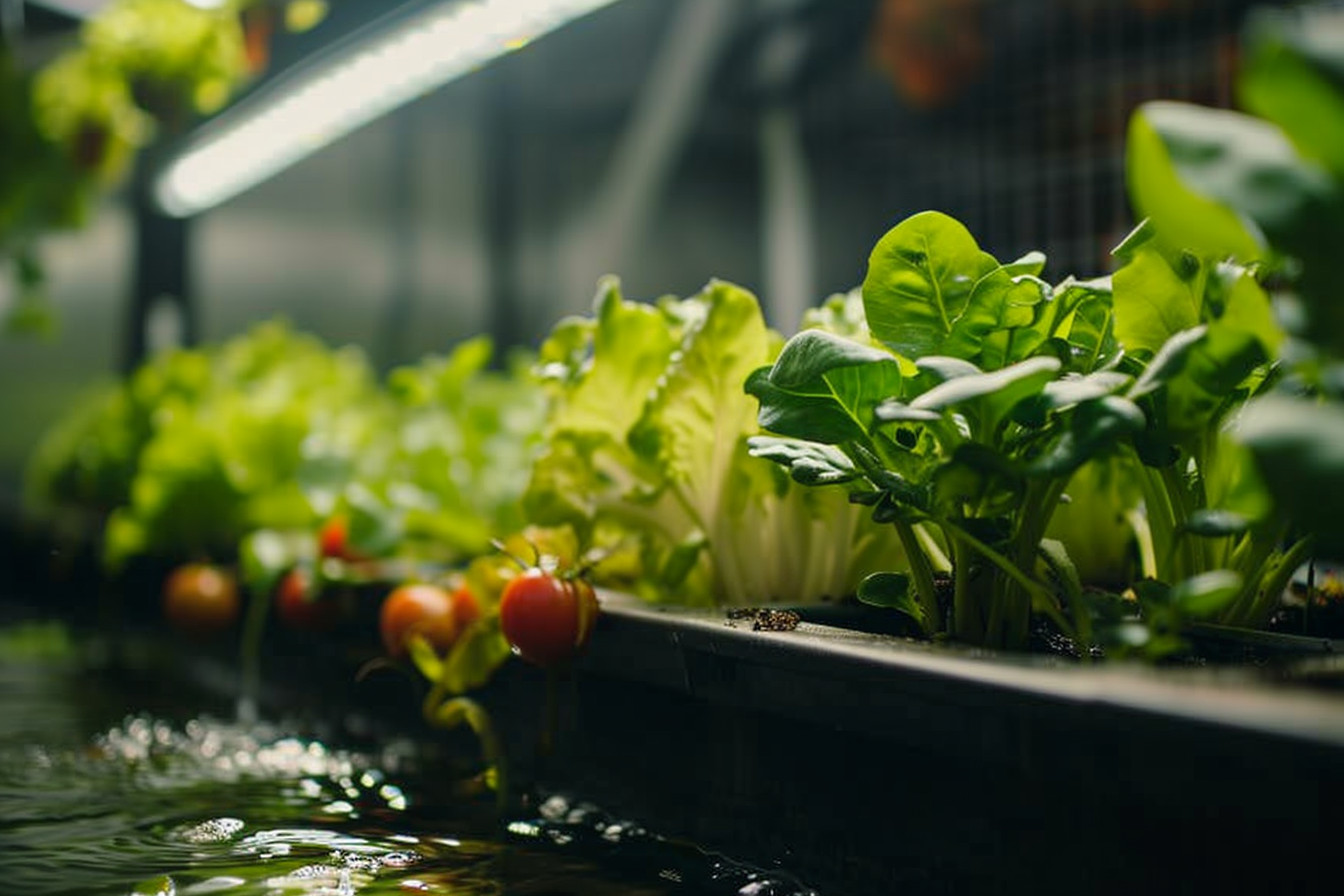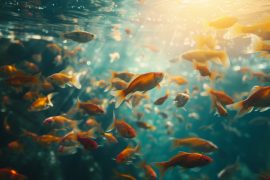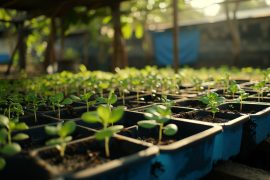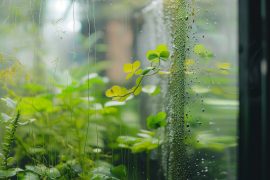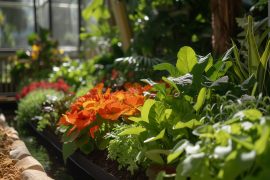Imagine marrying the serenity of a lush garden with the tranquil flow of a fish tank. That’s the peace you’ll find with a DIY aquaponic system, a perfect blend of aquaculture and hydroponics. It’s a harmonious ecosystem right in your own space, where the murmur of water and the whisper of leaves become your daily soundtrack.
I’ve always been fascinated by the idea of creating life-sustaining systems, and aquaponics is a testament to that. It’s like a living, breathing science project that grows both fish and plants together in one efficient, space-saving unit. So, let’s dive into the world of DIY aquaponics—I’ll walk you through building your first setup, making it as simple and enjoyable as possible.
Understanding Aquaponics: The Perfect Harmony of Fish and Plants
Aquaponics isn’t just about growing plants or raising fish—it’s the art of marrying the two into a symbiotic relationship where both thrive. As I delve deeper into this fascinating world, I can’t help but be amazed at the peace and balance it brings to a garden space. There’s something truly serene about watching this living ecosystem go about its business.
At its core, aquaponics pairs aquaculture, the raising of fish, with hydroponics, the process of growing plants in water, in a way that’s beneficial for both. Here’s why it’s magical: the fish produce waste, which I once thought of as a downside of aquaculture. But in an aquaponic system, this waste becomes a precious resource. The plants use the waste as nutrients and, in turn, clean the water for the fish. It’s a win-win!
If you’re like me, getting into the nitty-gritty of how all this works could seem daunting. Remember, I had to start from scratch too. So let’s break this down simply. Plants need nitrogen to grow, and fish waste is rich in ammonia, a form of nitrogen. However, plants can’t directly absorb ammonia. This is where beneficial bacteria come into play. They convert ammonia into nitrates, which plants can take up. In essence, we’re creating a natural filtration system that keeps our little swimmers happy and our greens…well, green!
To see this process in action is both calming and educational. In my experience, there’s nothing quite like the gentle hum of water and the soft sway of plant roots in an aquaponic setup. Plus, realizing that you’re cultivating life both above and below water adds a unique depth to the gardening experience.
Let’s look at some of the methods and histories behind it. The idea isn’t new; for centuries, cultures around the world have recognized the connections between flora and fauna in aquatic environments. Only recently have we packaged it into this neat term ‘aquaponics’ and started to perfect the processes and systems involved.
The Benefits of DIY Aquaponic Systems
When I started tinkering with a DIY aquaponic system, I never imagined that peace and harmony could be engineered. But that’s precisely what happened. The continuous flow of water, the gentle movement of fish, and the flourishing of plants come together to create an incredibly serene garden space. There’s something special about watching life thrive in such a balanced ecosystem—it’s a daily dose of tranquility.
Educating myself on the ins and outs of aquaponic gardening has been an adventure. It’s pretty amazing how these systems recycle water, conserve resources, and provide a habitat for both aquatic and plant life. Learning the science behind aquaponics made me appreciate the delicate balance of nature. And trust me, when I first heard words like “nitrogen cycle” and “biomedia,” I was scratching my head. But diving into the simple basics of this interdependent relationship was eye-opening. Anyone can grasp these concepts with a bit of time, and they make you look at your plate of veggies in a whole new light.
One of my favorite things about DIY aquaponics is how it cuts down on the work. No more worries about overwatering or underwatering, and I’ve said goodbye to traditional weeding. The system is mostly self-sustaining, which means more time to kick back and enjoy the zen of my garden without the usual back-breaking labor. Plus, growing my produce at home has been incredibly rewarding. There’s a unique satisfaction that comes from harvesting your greens and knowing they’re about as fresh as it gets.
I’ve jotted down a few solid perks that make the DIY route worth considering:
- Water efficiency: Aquaponics uses up to 90% less water than traditional soil-based gardening.
- Chemical-free: It’s a completely organic process, no pesticides or artificial fertilizers needed.
- Fresh and local: Harvest veggies and fish from your backyard—or even your living space.
- Education for all ages: It’s a great way to introduce kids (or adults!) to biological cycles and sustainable practices.
Planning Your DIY Aquaponic System: Location, Size, and Design
When I first started plotting out my DIY aquaponic system, I had this vision of creating a serene garden corner that would double up as my morning coffee spot. I wanted to meld my love for tinkering with my yearning for a tranquil space, and let me tell you, location is everything.
Finding the perfect spot is like picking the best seat in a movie theater – it has to enhance the entire experience. For me, a shaded area on my deck that received a couple of hours of soft morning sun seemed ideal. It’s essential to consider the light exposure; too much sun and your plants can get sunburnt, too little and they might as well nap all day.
Size matters too, but not in the way you might think. You don’t need a sprawling yard to set up an aquaponic system. A small balcony or a cozy corner in your living space can work wonders. I started small to get a hang of things. Less water meant less room for error and an easier maintenance routine. But if you’ve got space to spare, there’s no harm in going a bit larger!
Now let’s dive into design. Crafting your system is pretty much like building your dream home in miniature. The design phase is where your creativity can shine bright, but don’t get so carried away with aesthetics that you forget about functionality. Your system’s gotta be practical. I sketched out a few doodles and tapped into my inner architect before settling on a vertical design that saved space and gave me an almost panoramic view of my growing greens.
Keep in mind your system should be:
- Easily accessible for maintenance
- Sturdy enough to support the weight of the water and plants
- Safe from curious pets or wildlife
I’ve seen designs that range from uber-sleek, modern setups to rustic ones that look straight out of a fairy tale. Remember, it’s your space, your sanctuary. As long as it follows the basic principles of aquaponics, you’re good to go. My setup has evolved over time as I’ve learned more about what works best for the fish and plants; it’s an ongoing, living project that keeps teaching me new things.
Building Your Aquaponic System: Step-by-Step Guide
When I started crafting my aquaponic garden, the serenity it promised was as alluring as the fresh produce. Every planting decision was a whisper in nature’s grand symphony, and I was eager to construct my own corner of tranquility.
First off, selecting the right tank was paramount. This wasn’t just a container; it would become the lifeblood of my new ecosystem. I opted for a 55-gallon fish tank, a sizeable canvas to paint my aquaponic dreams upon. Here’s a little tip: don’t skimp on quality. Your fish and plants depend on a clean, safe environment, and a sturdy tank is the foundation.
choosing the fish was an interesting ballet. I had to consider the climate, the size of my system, and the kind of plants I was yearning to grow. Tilapia and goldfish are a safe bet for beginners; they’re hardy souls that tolerate a new gardener’s learning curve.
Moving to the grow beds, I settled on a flood and drain system. It mimics nature’s own ebb and flow, allowing roots to breathe and imbibe nutrients. I constructed my grow beds from sturdy containers and fitted them with bell siphons – a nifty feature that automatically drains the water, preventing over-saturation.
Assembling the System
As I assembled the system, every piece felt like a chapter of a book I couldn’t put down.
- I connected a pump in the fish tank to circulate water to the grow bed.
- I then used pipes to create a simple path for the water to reach the plants.
- After laying in the growing medium – lightweight expanded clay aggregate – I planted leafy greens and herbs.
Cycling the System
The heartbeat of my aquaponic garden began with cycling. This process establishes the beneficial bacteria essential for converting fish waste into plant food – nature’s recycling plan at its finest. I monitored ammonia, nitrite, and nitrate levels religiously. It was like setting the stage before the curtains rise for the opening act.
Choosing the Right Fish and Plants for Your DIY Aquaponic System
When I’m working on my little slice of aquaponic heaven, there’s a sense of peace that washes over me. It’s not just about growing food; it’s about sustaining life and creating a rhythm between the aquatic and plant worlds. Now, after setting up the tank and grow beds, it’s time to talk about the soul of your system: the fish and plants.
Picking the perfect fish is not just about what tastes good on the plate. It’s about finding species that thrive in the tank environment you’ve created. While tilapia is a popular choice due to their hardiness, there are others like catfish, carp, and various types of bass that are also well-suited for aquaponic systems. They’re like underwater gardeners, doing their part to keep things in balance.
Remember though, different fish have different needs. For example, tilapia love warmer waters, while trout prefer it cooler. If you’re hankering for a specific type of fish, you’ll want to make sure your system can maintain the right temperature for them.
On the flip side, plants play a pivotal role too. They’re the yin to the fish’s yang, absorbing nutrients the fish provide. I’ve found that leafy greens like lettuce, kale, and spinach grow exceptionally well, but I’ve also experimented with herbs and found that basil, mint, and watercress flourish too. Here’s a simple list of both fish and plants that are aquaponic-friendly:
- Fish:
- Tilapia
- Catfish
- Koi
- Carp
- Bass
- Plants:
- Lettuce
- Kale
- Spinach
- Basil
- Mint
And let’s not forget about the technical side. It’s crucial you understand the Nitrogen Cycle. This is the core of aquaponics. Fish waste produces ammonia which is toxic for fish, but luckily certain bacteria – the good guys – convert this ammonia into nitrates, which plants love. It’s a symbiotic relationship that’s beautiful and logical.
Maintaining Your DIY Aquaponic System: A Guide to Care and Troubleshooting
Tending to my DIY aquaponic system is like nurturing a little world of my own. There’s a soothing rhythm to monitoring the fish, checking the water quality, and tending to the plants. It instills a deep sense of connection with nature as I watch my mini ecosystem thrive.
Regular Checks Are Key
First things first: maintenance is routine. Every day I take a few moments to observe the fish’s behavior. Are they swimming vigorously, or are they listless? This can be a telltale sign of the water quality or their health. Acting on these observations is critical for preventing issues from blossoming into full-blown problems. Once a week, I test the water for pH, ammonia, nitrates, and nitrites, crucial markers for a balanced aquaponic system. A simple test kit does the trick and gives me peace of mind.
Feeding Frenzy: Less Is Often More
Overfeeding fish is a common rookie mistake. I’ve learned that less is more. Not only does this keep the fish healthy, but it also prevents excess food from decomposing and upsetting the water quality. A pinch of feed that the fish can finish in about five minutes is generally an ideal amount. I make sure to remove uneaten food after a short while to keep things clean.
The Root of the Matter: Plant Care in Aquaponics
When it comes to plants, yellowing or drooping leaves can signal a glitch in this garden matrix. They might need more nutrients or perhaps there’s an imbalance in the water. It’s a puzzle, but one that’s satisfying to solve. Some aquaponic gardeners might get technical, talking about iron deficiencies or potassium levels. I keep it simple – use a reliable aquaponic source for supplemental nutrients and observe how the plants respond.
Troubleshooting Tips That Save my Sanctuary
Snags will happen. Maybe the pump fails or a pipe clogs. But I don’t sweat it. The key is to act quickly. I keep a small toolkit and spare parts handy, just in case. Clearing blockages, replacing a pump filter or recalibrating a pH meter are all in a day’s work. It’s the troubleshooting that keeps my system running smoothly, just like caring for any cherished garden.
Scaling Up: Expanding and Improving Your Aquaponic System
As I’ve nurtured my aquaponic system from a fledgling setup to a stable ecosystem, a serene calm washes over me every time I witness its growth. The whisper of water flowing from the grow beds back into the tank is like a steady heartbeat, a reminder of the harmony we can craft between technology and nature. But there comes a point where the contentment gives way to a bubbling curiosity: what if I could scale this up?
The first step in expanding your system is strategic planning. It’s tempting to just add more tanks or grow beds, but that can disrupt the delicate balance. I learned that the hard way; one of my earliest upgrades led to an overworked pump and stressed-out fish. Now, I assess the capacity of my current equipment and always opt for scaling incrementally.
Key Considerations for Scaling Up
- System Balance: Ensuring the ratio of fish to plant area remains optimal
- Water Filtration: Upgrading filtering systems to handle the additional load
- Space Requirements: Determining the space needed for expansion without overcrowding
Expanding your aquaponic system isn’t just about adding more; it’s also about improving what you have. Innovative gardeners in the community have shared stories of integrating smart monitoring devices to keep tabs on their water quality or employing natural pest control methods to avoid harmful chemicals.
Enhancements to Consider for Improvement
- Automated Feeders: Reducing labor and regulating feeding times
- LED Grow Lights: For consistent plant growth, regardless of external weather conditions
- Solar Power: To make your system self-sustaining and environmentally friendly
Any expansion requires understanding the deeper nuances of the Nitrogen Cycle. Remember, more fish means more waste, which could potentially upset the balance unless your bacterial colonies are ready to handle the increase. Education is ongoing, and I often revisit literature on aquaponics to refresh and update my knowledge.
When I decided to introduce new species into my enhanced setup, it wasn’t just a technical decision, but an emotional one too. I picked colorful cichlids for their vigor and leafy greens that turned my grow bed into a lush tapestry. There was something profoundly satisfying in watching new life thrive, a testament to the efficacy and adaptability of an expanded system.
Final Thought: Creating Your Sustainable Oasis
So there you have it—my rundown on getting your hands dirty with a DIY aquaponic system. Remember, it’s all about starting small, learning the ropes, and then dreaming bigger. Don’t be afraid to experiment with new fish or plant varieties once you’ve got the basics down. It’s your sustainable oasis, after all. Keep an eye on that nitrogen cycle; it’s the heartbeat of your setup. And hey, if you’re ever feeling stuck, just think about the endless possibilities your aquaponic system holds. Happy building, and here’s to a greener, more self-sufficient future!
